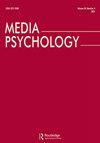真实化:准社会关系在增强易感性和新冠肺炎保护行为中的作用
IF 2.6
2区 心理学
Q1 COMMUNICATION
引用次数: 1
摘要
准确的风险认知的形成和采取防护措施对减少传染病的传播和阻止传染病的传播起着关键作用。然而,现有的研究表明,对风险的看法不一定与实际风险水平相关,包括COVID-19的风险水平。根据风险社会放大框架(SARF),我们测试了与患有COVID-19的名人建立副社会关系是否会使感染病毒的风险更加真实,从而放大对病毒的感知易感性,并减少对自己安全的偏见乐观感。研究1是一项全国性调查(N = 493),研究结果表明,有一个副社会朋友感染COVID-19与感知易感性增加有关,特别是对那些原本看起来抽象和模糊的人来说。研究2 (N = 228)通过确定观察到的PSR和感知易感性之间关系的潜在潜在机制——乐观偏见的衰减,补充了这些发现。这些发现有助于理解名人在健康和风险沟通中潜在作用的潜在机制。本文章由计算机程序翻译,如有差异,请以英文原文为准。
Making it Real: The Role of Parasocial Relationships in Enhancing Perceived Susceptibility and COVID-19 Protective Behavior
ABSTRACT Formation of accurate risk perceptions and adoption of protective measures play a key role in reducing transmission and stopping the spread of infectious diseases. Extant research, however, has shown that perceptions of risk are not necessarily correlated with the level of actual risk, including that of COVID-19. Informed by the social amplification of risk framework (SARF), we test whether having a parasocial relationship with a celebrity who has COVID-19 makes the risk of contracting the virus more real, thus amplifying the perceived susceptibility to the virus and reducing the biased sense of optimism that one is safe. Findings from Study 1, a national survey (N = 493), suggest that having a parasocial friend contract COVID-19, is related to increased perceived susceptibility, especially for those for whom it would otherwise seem abstract and vague. Study 2 (N = 228) complements these findings by identifying a potential underlying mechanism for the observed relationship between PSR and perceived susceptibility – attenuation of the optimism bias. Findings are discussed in terms of their contribution to understanding the underlying mechanisms of the potential role played by celebrities in health and risk communication.
求助全文
通过发布文献求助,成功后即可免费获取论文全文。
去求助
来源期刊

Media Psychology
Multiple-
CiteScore
8.60
自引率
7.10%
发文量
30
期刊介绍:
Media Psychology is an interdisciplinary journal devoted to publishing theoretically-oriented empirical research that is at the intersection of psychology and media communication. These topics include media uses, processes, and effects. Such research is already well represented in mainstream journals in psychology and communication, but its publication is dispersed across many sources. Therefore, scholars working on common issues and problems in various disciplines often cannot fully utilize the contributions of kindred spirits in cognate disciplines.
 求助内容:
求助内容: 应助结果提醒方式:
应助结果提醒方式:


